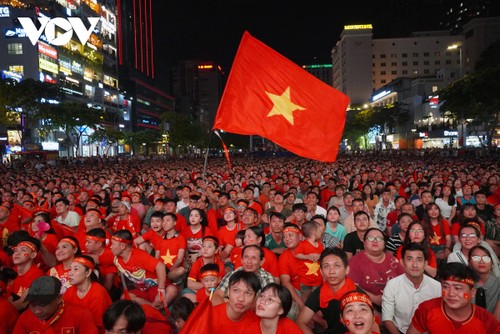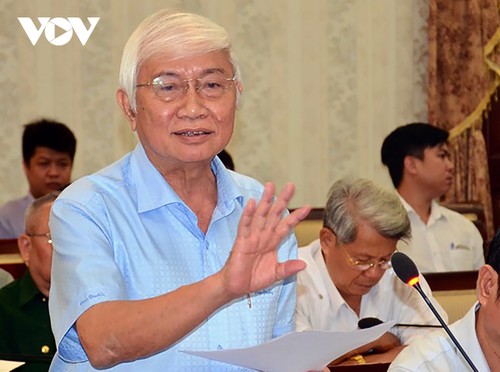 The national flag flies over Nguyen Hue pedestrian street during a football match of Vietnam's national team The national flag flies over Nguyen Hue pedestrian street during a football match of Vietnam's national team |
In March, 1940, the My Tho Provincial Party Committee was asked to design a flag for the Indochina Anti-Imperialist United National Front. Mr. Phan Van Khoe, the Provincial Party Chief assigned the job to Mr. Le Quang So, who was in charge of the Front’s work in My Tho.
Recalling stories heard in Con Dao prison about the first Party Chief Tran Phu who wished to make a red flag with a yellow star the national flag once the country was independent, So and Mr. Hoa Tri Ha, a party member from Ba Ria province, designed and created a red flag with a yellow star.
In July, 1940, at a conference of the Southern Party Committee in Tan Huong commune, Chau Thanh district, My Tho province, their flag was chosen, with the red representing blood, revolutionary enthusiasm, and victory, and the yellow symbolizing Vietnamese people’s skin and the bright soul of the Vietnamese nation. The five-pointed star symbolized the national unity of five social classes: intellectuals, workers, farmers, business people, and soldiers fighting on the same battlefield for national independence and freedom.
Doctor Le Van Ty, Deputy Head of the Tien Giang Provincial Party Committee for Communications and Education, said: "The red flag with the yellow star in the center is a treasure of the southern region. It reflects the region’s heroic struggle against foreign invaders in the cause of national construction and defense. The flag embraces the national soul and represents national unity, independence, freedom, self-reliance, and peace for Vietnamese people."
 Dr. Le Van Ty is Deputy Head of the Tien Giang Provincial Party Committee for Communications and Education Dr. Le Van Ty is Deputy Head of the Tien Giang Provincial Party Committee for Communications and Education |
In August, 1940, Mr. Phan Van Khoe asked the Chau Thanh district’s Party Committee to make a flag 2.5m by 1.8m in preparation for the Southern Uprising. It was extremely difficult to find enough yellow and red cloth to make the flag, as the authorities had outlawed all trading activities.
By November 23, 1940, the flag was flying atop a tree at Long Hung Communal House – the headquarters of the My Tho provincial Uprising Committee.
The flag soon appeared across My Tho and was recognized as Vietnam’s national flag in numerous documents of the Communist Party of Vietnam and the government of the Democratic Republic of Vietnam.
Professor Tran Van Giau once said, “Although the 1940 Southern Uprising failed, it bequeathed an important treasure to the Vietnamese nation, symbolizing Vietnam’s heroic revolutionary fight and the people’s faith in a bright future. The red flag with a yellow star in the center – the flag of the Southern Uprising – became Vietnam’s national flag.
 Associate Professor Doctor Phan Xuan Bien, member of the Central Theoretical Council and Vice Chairman of the Vietnam Association of Historical Sciences Associate Professor Doctor Phan Xuan Bien, member of the Central Theoretical Council and Vice Chairman of the Vietnam Association of Historical Sciences |
Associate Professor Doctor Phan Xuan Bien, a member of the Central Theoretical Council and Vice Chairman of the Vietnam Association of Historical Sciences, said: "The Southern Uprising produced a very special item, a red flag with a yellow star in the center, which symbolizes the Vietnamese nation’s staunch spirit and strong desire for independence, great national unity, and development. The flag has become the national flag of an independent Vietnam."
Bien says knowing the history of the national flag inspires patriotism and national pride in Vietnamese people, especially the young ones.
"The flag represents Vietnam’s vitality. Wherever it is flown it inspires national pride. We need to understand and teach its meaning, its origin, and its history, and inspire the will to defend it," added Bien.